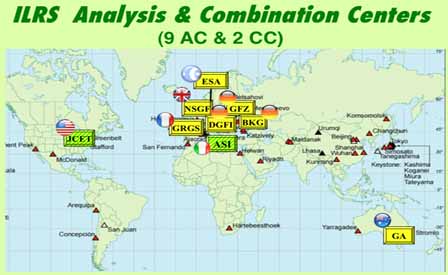Scientific Research Through Laser Ranging
The ILRS supports scientific research and data analysis using Satellite and Lunar Laser Ranging data and their products. The aim of these activities is primarily focused on geodetic and geophysical parameter estimation and geophysical model development. Furthermore, the main thrust of these activities addresses the needs of IERS with products that contribute to the development of an ever more accurate International Terrestrial Reference Frame (ITRF). The unique ability of ILRS to sense the Earth System center of mass with high accuracy, makes these products invaluable in the development of the ITRF, the prime product is the Global Geodetic Observing System (GGOS). The ILRS data and products are collected and generated under strict standards and they contribute to a wide range of scientific, engineering, and operational applications and experimentation.
In addition to collecting, merging, archiving and distributing Satellite Laser Ranging (SLR) and Lunar Laser Ranging (LLR) the ILRS interacts with the other IAG (Int. Assoc. of Geodesy) services under the GGOS umbrella, to harmonize the standards and conventions used for its operations and its data analysis and product generation activities. These activities are coordinated, supervised and validated by the Analysis Working Group, with the support of all Analysis Centers and Associate Analysis Centers. The official products of the ILRS are produced by the Combination Centers (primary and back-up) to ensure a unique product for the users with the highest accuracy and fully validated prior to its release. The service encourages international collaboration and strives to include as many different groups from various countries as possible, with a similar variety in the utilized software.
Recent News
Our colleague and friend Dr. Jorge del Pino, a long-term member of laser ranging community, passed away on Friday, January 17, 2025.
Born 1949 in Havana, his lifelong career in satellite observations started in the 1970s at the satellite tracking station Santiago de Cuba which operated a 1st generation laser system starting in 1977. In 1985, he defended his PhD thesis dedicated to the efficient second-harmonic generation for laser ranging at the Czech Technical University in Prague.
Jorge del Pino became the Cuban manager of the Intercosmos project of a 2nd generation SLR system which was operated between 1985 and 1998 in cooperation between ZIPE/GFZ Potsdam and CENAIS in Santiago de Cuba. He also contributed major parts of the real-time tracking software for the 3rd generation SLR systems in Potsdam.
Since 2013, he worked at Institute of Astronomy University of Latvia. Dr. Jorge del Pino contributed to the renewal of the SLR station Riga and to improving its performance. He participated in the station operations until the last days of his life. We will miss him greatly.
On behalf of the ILRS, our sincere condolences to his loved ones.
Read more...
We welcome the station to the network!





